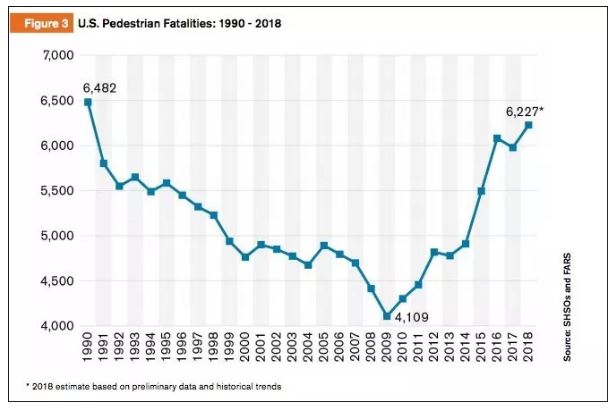Last week my wife mentioned that pedestrian deaths have risen a lot, and statistics from Governors Highway Safety Association show that is so, even if it was only 4 percent over the previous year. Though overall traffic deaths are down, pedestrian deaths have been on upswing since 2013. Should you be worried about walking? Not really, the numbers are absolute risk. A 50 percent increase since 2009 is about double of what swimming pools cause but from a relative risk point of view swimming is far more dangerous. There are only about 8,000,000 swimming pools in the United States and 35X as many cars, so journalists may be right in not promoting concern about relative risk here. Some are scaring people about SUVs using the pretense of caring about pedestrians, and use the selective framing that pedestrian deaths last year were 16 percent of all road deaths, up from 12 percent in 2009 - without noting that 2009 was the lowest year in the study, a statistical anomaly. They are about the same as 1990, when the SUB market was tiny in comparison to now.
Still, this is the kind of topic that a lot of people in a smart Science 2.0 may have solid answers for so I'd like to solicit comments. Well, evidence-based comments. Ban happy activists who want to eliminate SUVs or older people yelling about millennial avocados and earbuds aren't much value, unless you have data showing avocados lead to more traffic fatalities.
Here is their chart.

To get things started, here are the explanations I thought of offhand.
1. People are walking more. Walking is all the rage, we have smart devices nagging us to get our steps in and fad diet and health magazines jumped on the bandwagon. More people engaging in an activity means more injuries in absolute numbers, though perhaps not in a relative risk way. That the highest numbers were in the south, where the weather is better year 'round, give this some authority.
2. Smarphones. They didn't exist in 1990 so they can't be blamed for those deaths, and if you were on a mobile phone walking on the street then you were not staring at the ground, you were making eye contact with everyone you saw, to see if they saw how important you were. The lowest year in the data were 2009, when pedestrian deaths were 4,109. It seems no one was walking that year, either due to the bad economy or a million people were standing in line to buy an iPhone, which they would then use to listen to music while walking in intersections.
3. SUVs. There is a belief they are safer, and that defensive driving means being high enough in the air to see over cars in front of you. They have become so popular regular sedan lines are being limited or eliminated (say goodbye to Fiesta, Fusion, Focus - Ford Motor Company knows its buyers now only love F words if there is a -150 after it.) The report criticizes the number of SUVs in this case but then doesn't give them credit for the fewer overall traffic fatalities during the same period. SUVs can't be credited with one and not the other.
4. Distracted drivers. This has always been a concern but if overall fatalities are down pedestrians deaths should be also. New York City is now so congested it is almost impossible to die unless some terrorist intentionally mows people down. Their fatalities are down 70 percent since 1990. But no one wants more congestion so, as usual, what New York City does is generally unworkable.
5. Drunk drivers are also way down, whereas drunk pedestrians are up. More people are walking rather than driving impaired. That is a good thing. We are talking about relative risk so a drunk pedestrian walking into traffic at four miles an hour is always a better risk than a drunk driver in a car doing 50.
Let me know what you think.




Comments